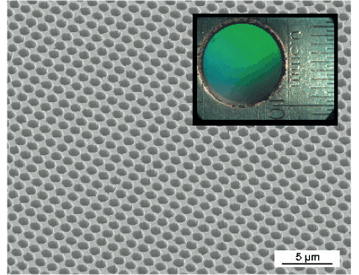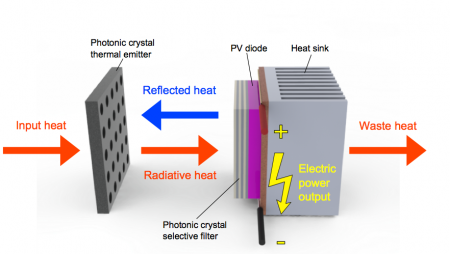Jul
28
A New Thermal Energy to Electricity Device
July 28, 2011 | 1 Comment
The Wiz Folks at MIT have a new design to take heat and make electricity. Using a new nanofabrication technique, MIT’s researchers make plates of tungsten with billions of regularly spaced, uniform nanoscale holes on the surfaces. Using a further development of the thermophotovoltaic system, the new type of photonic crystal serves as a thermal emitter, absorbing heat and then – because of its surface structure – radiating to a PV diode only those wavelengths that the diode can convert into electricity.
Today’s energy process as the U.S. Energy Information Administration explains, 92% of all the energy we use involves converting heat into mechanical energy and then often into electricity. A common path is coal or natural gas to steam to a turbine to a generator.
But today’s mechanical systems have drawbacks: their reliability is subject to moving parts breaking; their efficiency is relatively low; and they haven’t been successfully scaled down to the small sizes needed to match so many of today’s power-consuming devices, from sensors to smart phones to medical monitors.
Ivan Celanovic ScD ’06, research engineer in the Institute for Soldier Nanotechnologies (ISN) said, “Being able to convert heat from various sources into electricity without moving parts would bring huge benefits, especially if we could do it efficiently, relatively inexpensively, and on a small scale – a few millimeters, centimeters, or meters.”
Half a century ago, researchers developed thermophotovoltaics (TPV), an approach that couples a PV diode (the active part of a solar cell) with any source of heat. In a TPV system, a burning hydrocarbon, for example, heats up a solid piece of material called the thermal emitter; the thermal emitter radiates heat and light onto the PV diode; and the PV diode generates electricity. Because the thermal emitter is not as hot as the sun is, its radiation includes far more infrared wavelengths than occur in the solar spectrum. “Low band-gap” PV materials invented less than a decade ago can absorb more of that infrared radiation than standard silicon PVs can; but much of the heat is still wasted, so efficiencies remain relatively low.
Starting with TPV the MIT researchers have fabricated a button-sized power generator that’s fueled by butane, can run three times longer than a lithium-ion battery of the same weight, and can be recharged instantly by snapping in a tiny cartridge of fresh fuel. Another device, powered by a radioisotope, should generate electricity for 30 years without refueling or servicing—an ideal source of electricity for spacecraft that head out of our solar system.
Celanovic explains their solution is design a thermal emitter that radiates only the wavelengths that the PV diode can absorb and convert into electricity – and suppresses emission of all other wavelengths. “If you have perfect spectral matching between your heat source and your PV diode, you’ll get optimal efficiency for the overall system,” he said.
Marin Soljačić, associate professor of physics and ISN researcher takes the explanation further, “But how do we find a material that has this magical property of emitting only at the wavelengths that we want?” The answer: make a photonic crystal. Take a sample of material and on its surface create some nanoscale features – say, a regularly repeating pattern of holes or ridges. Light will now propagate through the sample in a dramatically different way than it did when the material was in its natural form.
This powerful approach – co-developed by John D. Joannopoulos, the Francis Wright Davis Professor of Physics and ISN director, and others – has been widely used to improve lasers, light- emitting diodes, and even optical fibers. But to the MIT team, this new type of material was exactly what they needed to engineer the spectrum of their thermal radiation to what their PV diode could use.
To start, they needed a material that could be heated to extremely high temperatures and then glow with an intensely bright light. The obvious choice was tungsten, which for 100 years has served as the filament in incandescent light bulbs. To make a slab of tungsten into a photonic crystal, they created an array of tiny pits – cylindrical cavities – on the surface. When the slab heats up, it generates a bright light but now with an altered emission spectrum.
Then each pit acts as a resonator, capable of giving off radiative heat at predetermined wavelengths. That provides wavelength selectivity. Celanovic offers as an analogy an acoustic resonator. “It’s kind of like when you put a seashell next to your ear and you hear a humming noise. You hear the noise amplified at the resonant frequencies of the seashell cavity. It’s the same principle, the same physics, but rather than acoustic resonance, this is electromagnetic resonance,” he said.
To implement their “designer material,” the researchers needed to find a practical means of fabricating a nanoscale structure in tungsten. After much work, they developed a method based on lithography and reactive ion etching, processing techniques used to make small features, for example, on micro-processors. In the MIT work, interference between two overlapping laser beams creates an etch mask with identical tiny holes, which are then transferred to a tungsten substrate by reactive ion etching. Using that approach, the MIT team has fabricated tungsten photonic crystals that are 1 cm in diameter with surfaces that contain billions of tiny holes, equally spaced from one another and nearly uniform in diameter and depth.
By controlling the geometry of the tiny cylinders bored in the tungsten the emission spectra can be distinctly set.
Heat raises the temperature of the tungsten photonic crystal – the thermal emitter – that in turn radiates heat at selected wavelengths toward the PV diode, and the diode converts it into electric power. Even with careful tailoring, the tungsten emitter delivers some heat at wavelengths that the PV diode cannot convert into electricity. To prevent that waste, the researchers mount on the face of the diode another photonic crystal, this one fabricated with a series of alternating layers of silicon and silicon dioxide – a nanostructure that can be tailored to transmit certain wavelengths and reflect others. Here, it reflects any radiation at unacceptable wavelengths back to the tungsten emitter, where it is reabsorbed and subsequently reemitted to provide more heat at wavelengths that the PV diode can use.
The MIT team is working with collaborators at MIT and elsewhere to create several novel electricity-generating devices.
One example is the micro-TPV power generator, a button-sized solid-state device that uses as its heat source hydrocarbon fuels such as butane or propane. At the center of the device is a “micro-reactor” designed by Klavs Jensen, the Warren K. Lewis Professor of Chemical Engineering, and fabricated in the Microsystems Technology Laboratories. This tiny reactor is a silicon chip with an interior channel where injected fuel undergoes catalytic reaction, generating heat. Photonic crystals are deposited on both the top and bottom surfaces of the micro-reactor, and low band-gap PV diodes are placed above and below the reactor separated by tiny gaps. Heated by the micro-reactor, the TPV system generates electricity, which passes into an electronic circuit that was specially designed by Robert Pilawa, graduate student, and David Perreault, associate professor, both of electrical engineering and computer science. The circuit dynamically adjusts the voltages and currents to suit a smart phone, sensor, or other device while extracting the maximum amount of power from the TPV system.
Celanovic said prototypes of their micro-TPV power generator are “pretty exciting.” The devices achieve a fuel-to-electricity conversion efficiency of about 3% – a ratio that may not sound impressive, but at that efficiency their energy output is three times greater than that of a lithium ion battery of the same size and weight. The TPV power generator can thus run three times longer without recharging, and then recharging is instantaneous: just snap in a new cartridge of butane. With further work on packaging and system design, Celanovic is confident that they can triple their current energy density. “At that point, our TPV generator could power your smart phone for a whole week without being recharged,” he says.
The MIT team has other ideas based on the technology starting in the lab, including radioisotopes that offer much promise. But for most of us now the conversion of solar energy is in the forefront. In that the scientists are looking at ways to use their photonic crystal to improve the conversion of solar energy into electricity. For example, optical concentrators such as parabolic mirrors could focus solar radiation onto a photonic crystal absorber and emitter, which would reshape the solar spectrum to better match the properties of a PV cell.
There’s a lot of potential in this field. While the seemingly low efficiencies are getting addressed, the applications look to be racing ahead. The power by weight and size is very attractive as noted in the comparison with lithium batteries.
The MIT article is a long and worthwhile read. Even this summary post is long. As devices and tools get more compact and efficient the MIT TPV may have a much larger application field than thought. Wherever there is a battery, there could be a TPV instead.
Comments
1 Comment so far




Now if one could hook on of these up to an ECat device as being designed by Defkalion and Rossi, say a 5kW unit, what do you think the tune-able output would be?